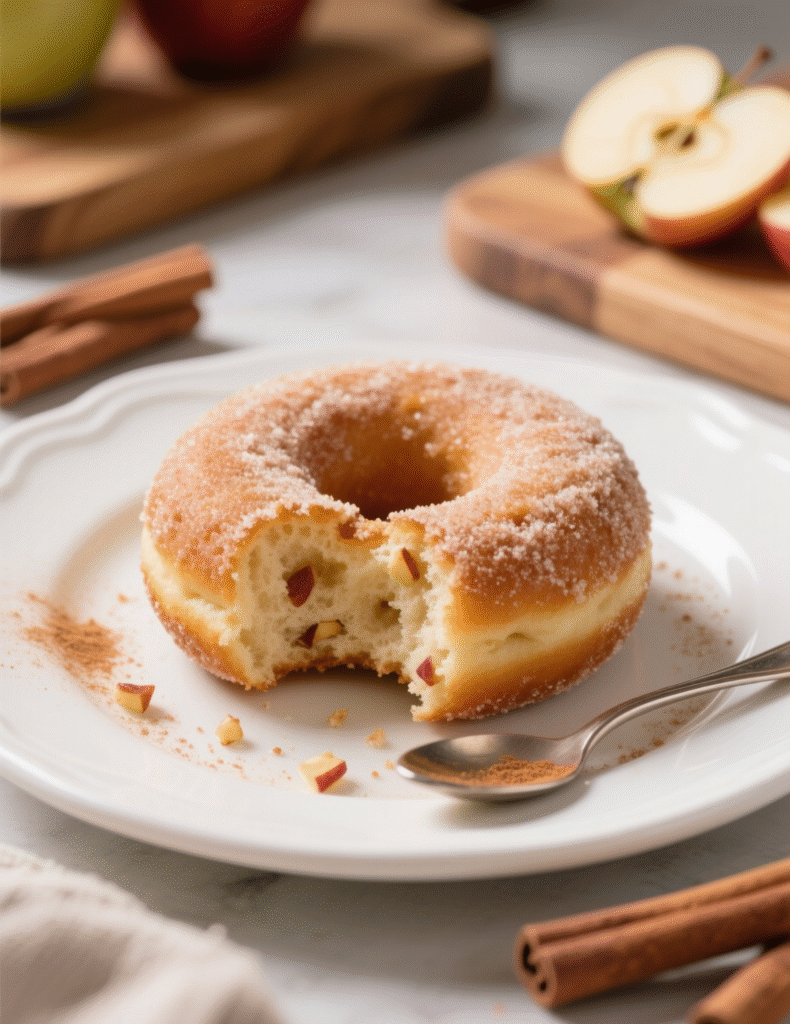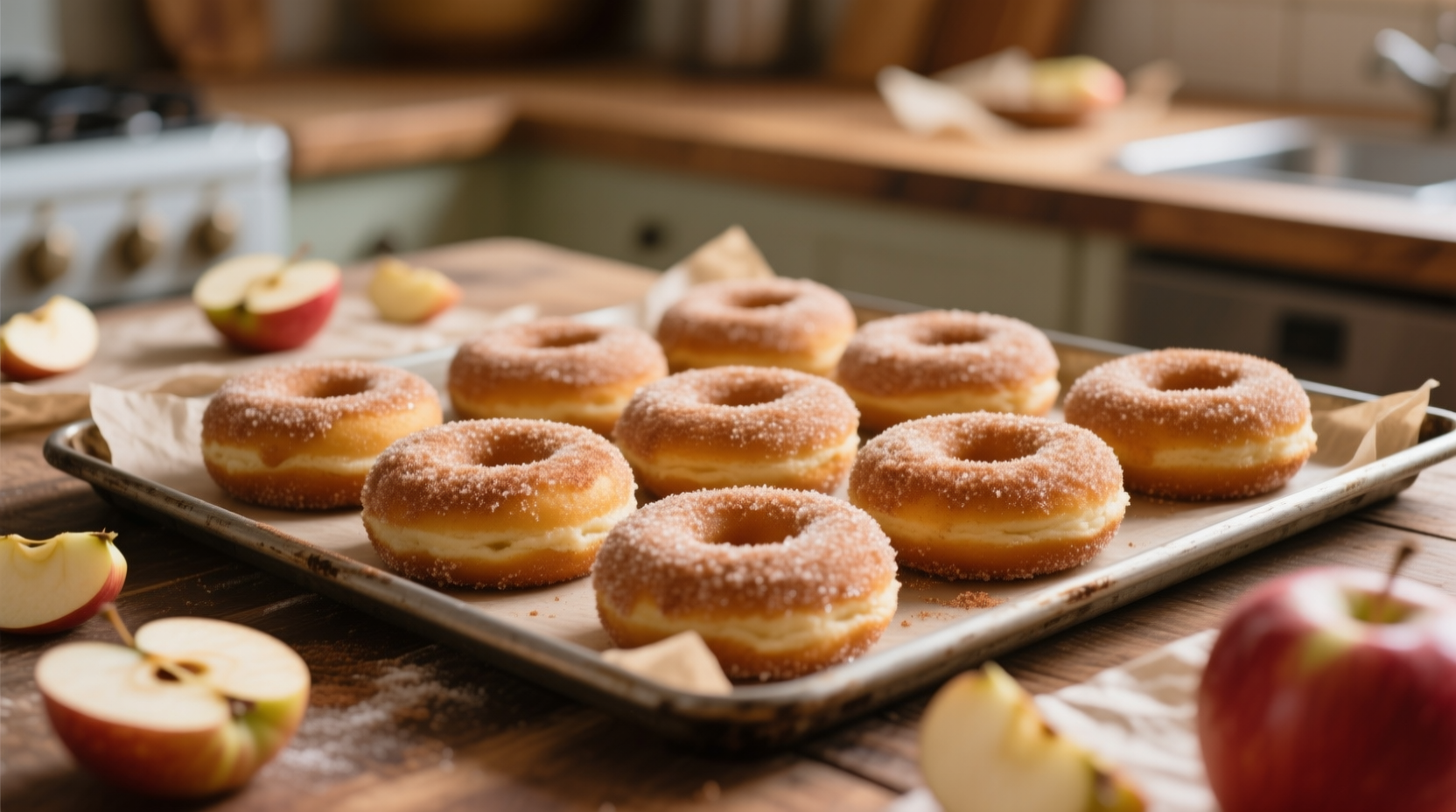There’s a reason apple cider donuts show up everywhere the moment leaves start falling. They’re nostalgic, seasonal, and irresistibly fragrant. But most recipes floating around cut corners, and professionals know the devil is in the details. This guide dives deep into the baked apple cider donut recipe—crafted for six servings—but with analysis and insight that even a pastry chef will nod at.
Why Apple Cider Donuts Deserve Respect
Apple cider donuts are not just another fall gimmick. They’re an old New England classic, often sold at cider mills as soon as the presses start running. The defining feature isn’t just the apple cider itself, but the way it’s reduced to a syrupy concentrate, intensifying flavor. Skip that step and you end up with cake disguised as tradition.
Research by the U.S. Apple Association shows that cider sales spike nearly 45% during September and October. That surge isn’t about juice—it’s about ritual. Donuts fit that ritual like a glove, turning apples into something you can hold, glaze, dunk, or eat straight from the pan while still warm.
The Core Recipe Breakdown
Before diving into techniques, let’s lock in the actual formula. For six servings, the ingredient list balances concentrated flavor, moisture, and structure. This recipe avoids frying, instead relying on a baked approach that professionals often prefer in commercial or high-output kitchens to minimize oil management and inconsistency.
Ingredients (For 6 Servings)
- 1 ½ cups fresh apple cider (reduced to ½ cup)
- 1 ¼ cups all-purpose flour
- 1 tsp baking powder
- ¼ tsp baking soda
- ½ tsp ground cinnamon
- ¼ tsp nutmeg (freshly grated if possible)
- ¼ tsp fine sea salt
- 1 large egg, room temperature
- ½ cup granulated sugar
- ¼ cup packed light brown sugar
- ¼ cup unsalted butter, melted and cooled
- ⅓ cup sour cream (or full-fat Greek yogurt for tang)
- 1 tsp pure vanilla extract
For Coating:
- ¼ cup unsalted butter, melted
- ½ cup granulated sugar
- 1 tsp ground cinnamon
Yield: 6 standard baked donuts
The Science Behind It
Apple cider reduction is non-negotiable. Reducing from 1 ½ cups to ½ cup concentrates natural fructose and malic acid, giving a stronger apple backbone. Without reduction, the batter lacks both depth and aromatic sharpness. Sour cream introduces acidity, balancing sweetness and tenderizing gluten, while butter brings richness. Nutmeg’s volatile oils add warmth but dissipate quickly, so grind fresh if you can.

Step-by-Step Methodology
Step 1: Reduce the Cider
Pour cider into a small saucepan. Simmer gently until it reduces to about ½ cup. This takes around 20 minutes over medium heat. Stir occasionally to prevent scorching. Professionals know never to rush reduction with high heat—it caramelizes unevenly and ruins the balance.
Step 2: Dry Mix
In a bowl, whisk flour, baking powder, baking soda, cinnamon, nutmeg, and salt. Always sift the flour if it’s compact. Donuts rise quickly; clumps here will haunt you later.
Step 3: Wet Mix
In another bowl, whisk egg, both sugars, melted butter, sour cream, vanilla, and reduced cider. The order matters. Dissolving sugars fully before folding in cider prevents grainy texture after baking.
Step 4: Combine
Add dry to wet. Fold gently with a spatula. Over-mixing creates tunnels inside the crumb. Professionals treat this step almost like muffin batter—just enough for the flour to disappear.
Step 5: Pipe & Bake
Spoon batter into a piping bag. Pipe into a greased donut pan, filling each cavity about ¾ full. Bake at 350°F (175°C) for 12–14 minutes. Look for a light golden edge and a spring-back texture when touched. Underbake and they collapse, overbake and they lose moisture.
Step 6: Coat
Cool slightly, then brush with melted butter. Toss in a sugar-cinnamon blend. Timing here matters: too hot, the sugar melts; too cold, it won’t adhere. Aim for that 5-minute sweet spot.
Professional Notes and Adjustments
Flour Choices
Switching from all-purpose to cake flour softens crumb structure. But don’t do a direct swap. Use a 2:1 ratio of cake flour to bread flour for an airy yet stable donut. That’s a trick many bakeries lean on when trying to upscale production.
Spice Balancing
Most home recipes drown in cinnamon. In professional kitchens, balance is king. A pinch of cardamom or allspice lifts flavor complexity. Use restraint though—0.25 grams can tilt the entire profile.
Sugar Control
Granulated and brown sugars together balance sweetness and moisture retention. Replacing 20% of the sugar with maple sugar creates a deeper flavor without overwhelming the apple. This adjustment pairs beautifully with cider glazes.
Texture Variations
Some bakers glaze rather than sugar-coat. A thin cider glaze (powdered sugar plus cider concentrate) creates a glossy finish ideal for display cases. But sugar coating wins for texture contrast. It crackles under teeth in a way glaze simply can’t.

Common Mistakes to Avoid
- Skipping cider reduction – leaves donuts tasting bland.
- Over-mixing – creates gummy interiors.
- Incorrect spice ratios – too much cinnamon flattens flavor.
- Under-greasing pans – baked donuts stick easier than fried ones.
- Using cold ingredients – batter won’t emulsify properly.
Nutritional and Practical Considerations
A serving (1 donut) lands around 280 calories. That breaks down into 38g carbs, 4g protein, and 12g fat. Compared to fried versions, you save roughly 40% in fat content. For professionals, baked donuts make sense in contexts like corporate catering or school kitchens where fryer management is impractical.
Emerging food trends also show growing demand for “better-for-you” indulgences. Baked apple cider donuts hit that sweet spot: familiar comfort food, but less greasy, and easier to brand as seasonal wellness-friendly treats.
Variations for Professionals
Gluten-Free Approach
Replace flour with a 1:1 certified gluten-free blend that includes xanthan gum. Test moisture adjustments—gluten-free flours absorb differently. Often, 1 tbsp extra cider reduction restores balance.
Vegan Option
Swap butter for coconut oil, egg for flax egg, and sour cream for oat yogurt. Baking powder adjustments (slightly higher, around 1 ¼ tsp) ensure proper lift without eggs.
Scaling for Production
In bakeries, scaling this recipe requires careful monitoring of cider reduction. Always reduce in large shallow pans for efficiency. Cooling time between reductions avoids burnt undertones.
Expert-Level Tips for Perfection
- Chill batter for 20 minutes before piping. This relaxes gluten strands and sharpens structure.
- Use silicone pans instead of metal. They release donuts more cleanly and regulate heat gentler.
- For storage, avoid airtight containers. Moisture condensation ruins sugar coating. Use a loosely covered tray at room temperature for up to 24 hours.
- Pair flavors. Apple cider donuts sing with salted caramel drizzle, chai whipped cream, or even a sharp cheddar slice—yes, some regions actually serve them that way.
Conclusion
Baked apple cider donuts are more than a seasonal bake—they’re a study in balance. Reduction sharpens flavor, proper mixing keeps texture delicate, and timing decides whether sugar sticks or slides away. For six servings, this recipe delivers classic New England flavor with professional-level control.
The real takeaway? Respect the cider. Reduce it slow, fold it gently, coat it just right. When you serve them warm, sugar sparkling in the light, you’re not just giving people donuts—you’re giving them autumn in a bite.
FAQs
What makes baked apple cider donuts different from fried ones?
Baked donuts are lower in fat, more consistent in texture, and easier to flavor precisely.
Can I use regular apple juice instead of cider?
Yes, but the flavor will be milder; reduce it to concentrate sweetness.
Why should I reduce apple cider before adding it?
Reducing concentrates flavor and prevents excess moisture in the dough.
What flour is best for a soft donut texture?
Pastry flour works best for a tender, delicate crumb.
Can I substitute butter with oil?
Yes, oil keeps donuts moist while butter adds flavor; a mix works best.
How do I prevent dense donuts?
Avoid overmixing and measure flour precisely to keep the crumb light.
What spices enhance apple cider donuts?
Cinnamon, nutmeg, ginger, cardamom, and allspice add depth.
How should I store baked donuts?
Keep them in an airtight container at room temperature for up to 24 hours.
Can these donuts be frozen?
Yes, wrap individually in parchment and thaw at room temperature before reheating.
Are there gluten-free or vegan options?
Yes, use almond or oat flour, plant-based butter, and flaxseed as egg replacer.
Why toast spices before mixing?
Toasting intensifies aroma and brings out deeper, warmer flavors.
How do I get even browning on baked donuts?
Rotate the pan halfway and ensure the oven is properly preheated.
What’s a professional finishing touch?
Cinnamon-sugar coating, cider glaze, or a pinch of sea salt over glaze.
Can I add apple pieces to the batter?
Yes, small caramelized apple bits give extra texture and flavor bursts.
How long should I bake donuts?
12–15 minutes at 350°F until lightly golden and springy to the touch.

Mariana is a passionate home cook who creates delicious, easy-to-follow recipes for busy people. From energizing breakfasts to satisfying dinners and indulgent desserts, her dishes are designed to fuel both your body and hustle.
When she’s not in the kitchen, she’s exploring new flavors and dreaming up her next recipe to share with the Foodie Hustle community.

